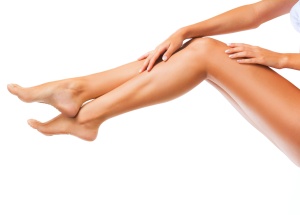Varicose veins of the lower limbs are one of the most common diseases, not only in Poland but also worldwide. This condition is called a lifestyle disease or disease of civilization. Varicose veins affect women five times more often than men. The negative impact of female hormones on vascular muscle is to be blamed. Women also often wear high heels and tight clothing, which influence the health of their blood vessels.
More information regarding rectal varices can be found: Proctological procedures. Removal of rectal varices.
The development of varicose veins may be caused by:
- Hormonal contraception
- HRT (hormone replacement therapy)
- Persistent constipation
- Pregnancy
- Smoking
- Diet
- Lifestyle (lack of exercise)
- Genes
- Working mode (prolonged sitting or standing)
If varicose veins have already begun to form, it is not possible to completely stop this process. There is a need to remove them, because we will not be able to deal with them on our own.
The basis of the modern varicose veins treatment is proper identification severity of the disease and choosing the least invasive, but the most effective method of treatment. The most important examination in the diagnosis of venous diseases, beyond the physical, is the Doppler ultrasound.
Types of treatment
The operation of varicose veins
Indications
- Symptoms associated with the occurrence of varicose veins, for example: swelling, leg pain, permanently tired legs
- Recurrent inflammation of varicose veins
- Bleeding from varicose veins
- Varicose disease complications in the form of ulcers
- Progressing of varicose veins symptoms despite the usage of non-invasive treatments
If you have noticed any of these symptoms, you should seek medical advice for starting appropriate treatment.
Contraindications
Surgical treatment of varicose veins is not recommended in patients with a bleeding diathesis, deep vein occlusion, with cancer, acute viral infection, HIV infection, autoimmune diseases, as well as in ischemic limb. The treatment is not appropriate for people who use immunosuppressive medications, suffer from bleeding disorder or take medications that prolong bleeding time (anticoagulants), pregnant or breastfeeding women.
The procedure is not performed in patients with severe obesity, skin ulcers or wounds due to the high risk of complications.
The course of treatment
The operation leads to partial or full removal of one of the superficial veins, ligation of the veins (superficial vein system connecting with the deep veins), or removal or obliteration of the individual varicose veins. Usually after varicose vein surgery patients are unable to work for a period of 7 days.
Postsurgical recommendations
- Wearing the elastic bands/stockings/ knee socks specially designed for varicose veins (first 2-3 weeks)
- Taking prescribed medication
- Avoiding exercising for at least 2 weeks
- Avoiding prolonged sitting and standing for a period of 2 weeks
Mini-Phlebectomy Varady
Mini-phlebectomy Varady is the technique used for certain types of varicose veins removal by surgical instruments specially designed for atraumatic removal of varicose veins.
Indications
- Reticular varicose veins
- Isolated varicose veins and venous trunks
- Varicoses of connecting veins
Contraindications
The treatment is not recommended during pregnancy, lactation, in patients with cancer, acute viral infection, HIV infection, autoimmune disease. The treatment is not appropriate for people who use immunosuppressive medicine, who suffer from a bleeding disorder or take medications that prolong bleeding time (anticoagulants).
The course of treatment
The doctor takes small (1-2 mm) incisions in the skin, then, using special hooks, cuts out the affected vein. The incisions are closed with Steri-Strips or stitches. Mini-phlebectomy is the surgical technique that leaves no scars. Patients can return to the regular activity shortly after the surgery.
Depending on severity of the disease mini-phlebectomy Varady technique may require repetition.
Postsurgical recommendations
It is recommended to take a half hour walk right after the operation. You should use compression bandaging or compression stockings. Avoid staying too long in a sitting position; motion is highly recommended! It is also recommended to avoid exposure to the sun for a period of four weeks after the treatment.
Sclerotherapy
Sclerotherapy is a non-invasive elimination of blood flow in the varicose veins by injection of medicinal substances to the veins.
Indications:
- Varicose veins of the lower limbs
- Hemorrhoids
- Spider veins appearing at various parts of the body
Contraindications
The treatment is not recommended during pregnancy, lactation, in patients with cancer, acute viral infection, HIV infection, autoimmune disease. The treatment is not appropriate for people who use immunosuppressive medications, who suffer from a bleeding disorder or take medications that prolong bleeding time (anticoagulants).
The course of treatment
Unlike other treatments, sclerotherapy is painless and does not require anesthesia and use of pain relief medications.
The treatment is preceded by Doppler ultrasound examination. After getting acquainted with the results, doctor determines the order and the application site of medication, and then injects sclerosing agent into the vein with a very thin needle that causes vein fibrosis and closure. Patients can return to the regular activity shortly after the treatment.
To achieve the ultimate outcome of the treatment sclerotherapy needs to be repeated several times.
Postsurgical recommendations
The recommendations after surgery sclerotherapy are individually suited to the patient needs, the type of disease and method of administration sclerosing to the vein.
After completing the procedure should be applied compression bandage or compression stockings.
Avoid staying too long in a sitting position. It is also recommended to avoid exposure to the sun for 4 weeks after surgery.
After sclerotherapy of hemorrhoids patient should keep an easily digestible diet.
For your information
Chronic venous insufficiency starts usually from the spider veins. They are located mostly on the sides of the thighs, under and around the knees. Spider veins are seen as a cosmetic problem, but they should not be underestimated, as it can become over time cause a variety of ailments and edema. Untreated, chronic venous insufficiency may develop into progressive disease, leading to poorly healing ulcers.
Neglected or improperly treated venous ulcers lead to serious complications and may result in amputation of limb.









